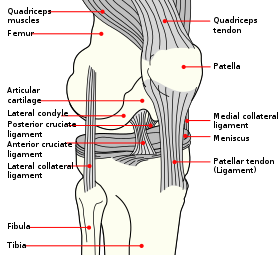Anterior cruciate ligament injury
| Anterior cruciate ligament injury | |
|---|---|

Diagram of the right knee
|
|
| Specialty | Orthopedics |
| Symptoms | a "pop" with pain, swelling of knee |
| Causes | noncontact athletic injury or direct blow |
| Risk factors | athletes, female gender |
| Diagnostic method | physical exam, MRI |
| Prevention | neuromuscular training, core strengthening |
| Treatment | physical therapy, surgery |
| Frequency | > 200,000 per year in U.S. |
| Classification | |
|---|---|
| External resources |
Anterior cruciate ligament injury occurs when the biomechanical limits of the ligament are exceeded (over-stretched). The anterior cruciate ligament (ACL) is an important internal stabilizer of the knee joint. The primary function of the ACL is to prevent hyperextension; its secondary function is to restrain tibial rotation and varus/valgus stress.
ACL injury is most commonly a non-contact injury involving a sudden stop or twisting movement, such as a dismount from a layup in basketball. ACL injury occurs more frequently in athletes than in the general population and is prevalent in alpine skiing, association football, American football, Australian rules football, basketball, rugby, professional wrestling, martial arts, and gymnastics. It is also known to be about three times more common in women than men.
The consequences of the injury depend on how much the stability of the knee is affected, and the extent to which other structures have been involved. If instability is evident, particularly rotatory instability, then the menisci may get injured; this may lead to progressive, degenerative, arthritis of the knee.
An individual may feel or hear a "pop" in their knee during a twisting movement or rapid deceleration, followed by an inability to continue participation in the sport and early swelling from hemarthrosis. This combination is said to indicate a 90% probability of rupture of the anterior cruciate ligament. An individual may experience instability in the knee once they resume walking and other activities, and they may feel their knee is "giving out".
ACL injury is most commonly a non-contact injury that occurs when an individual stops suddenly or plants his or her foot hard into the ground (cutting). ACL injury also has been linked to heavy or stiff-legged landing; the knee rotating while landing, especially when the knee is in an unnatural position.
Significantly, many ACL injuries occur in athletes landing flat on their heels. This movement directs the forces directly up the tibia into the knee, while the straight-knee position places the anterior femoral condyle on the back-slanted portion of the tibia. The resultant forward slide of the tibia relative to the femur is restrained primarily by the now-vulnerable ACL.
ACL injuries also can be caused by direct contact or trauma, such as in a motor vehicle collision or from a tackle in football. A severe form of ACL injury caused by direct contact is called the "unhappy triad," also known as the "terrible triad," or "O'Donaghue's triad." The "unhappy triad" involves injury of the anterior cruciate ligament, the medial collateral ligament, and the medial meniscus.
...
Wikipedia
